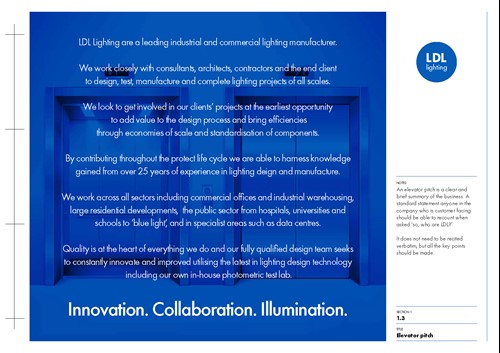Apparently the concept of the ‘elevator pitch’ originated in the offices of Vanity Fair in the nineties. As the story goes a reporter kept attempting to pitch a story to the Editor-in-chief but couldn’t pin him down. So she waited until they were taking the lift, then jumped in with them as she knew there was nowhere to run and she’d have his undivided attention. She also knew this was going to be a very brief opportunity so she boiled the idea down to the bare essentials so it could be explained in about half a minute.
I have to admit that we’re advocates of the ‘elevator pitch’; that quick 30 second summary of what a company does and how it does it. We usually write one as part of brand identity program and advise our clients to get everyone in their organisations familiar with the basic gist at least – it doesn’t have to be recited verbatim, but everyone should be able to provide a version whenever they’re asked ‘where do you work then, and what do they do?’

These ideas evolve all the time of course, and the elevator pitch is essentially a more informal version of the old mission statements which tended to be a bit too ‘preachy’ and often the mission didn’t match the reality. As customers get more exposure to these things they get smarter and start to recognize sales speak, which is generally a big turn off and just leads to them putting the shutters up. In turn, this leads us to question the elevator pitch and whether a generalized statement is in fact the most effective way of communicating your offer?
Prospects and customers are, obviously, all different with different requirements, budgets, challenges, locations, markets, sectors and so on. The elevator pitch condenses your language so it’s short and snappy which is great, but it also standardises it and tries to appeal to everyone simultaneously. Could it be better to try to encourage a dialogue? To lead with more questions and then find a way to talk about your offer in ways the audience can relate to, individually. Maybe we should try to get creative and engaging with delivery and then get more specific based on what the audience tells you about themselves and their business needs.
Customers naturally want it all – to pay less and get more, to get twice the value in half the time, they want the features to be clear and the benefits attainable. Sharing what you do with them in a way that relates to their needs and expectations, without compromising your offer by sounding like a market trader who can offer anything, requires its own skill set. You need to be clear about your offer but able to adapt and communicate it in a way that the prospect can relate to and you can only do this by understanding their priorities. Sometimes this can lead to a session to validate the audience and learn more about them through real feedback rather than hypotheses. The ‘why’ is now a combination of why we do what we do, why they need it, what it can deliver and where alignment exists. When this can be successfully communicated, it becomes a collaborative experience that leads to better working relationships which are generally more loyal.
It’s still good practice to follow the basic principles of the elevator pitch – a simple, succinct and really clear message – but start by questioning and listening so that you can adapt your value proposition to meet the audience’s needs. This can be done in the same amount of time it takes to make a generic offer, but it will be more engaging and compelling because it’s more personal. If this moves onto a sale and working together, then naturally it’s essential to deliver on the promises you made to them to maintain and build your reputation.

